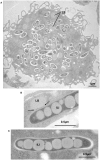Experimental Models of Foamy Macrophages and Approaches for Dissecting the Mechanisms of Lipid Accumulation and Consumption during Dormancy and Reactivation of Tuberculosis
- PMID: 27774438
- PMCID: PMC5054039
- DOI: 10.3389/fcimb.2016.00122
Experimental Models of Foamy Macrophages and Approaches for Dissecting the Mechanisms of Lipid Accumulation and Consumption during Dormancy and Reactivation of Tuberculosis
Abstract
Despite a slight decline since 2014, tuberculosis (TB) remains the major deadly infectious disease worldwide with about 1.5 million deaths each year and with about one-third of the population being latently infected with Mycobacterium tuberculosis, the etiologic agent of TB. During primo-infection, the recruitment of immune cells leads to the formation of highly organized granulomas. Among the different cells, one outstanding subpopulation is the foamy macrophage (FM), characterized by the abundance of triacylglycerol-rich lipid bodies (LB). M. tuberculosis can reside in FM, where it acquires, from host LB, the neutral lipids which are subsequently processed and stored by the bacilli in the form of intracytosolic lipid inclusions (ILI). Although host LB can be viewed as a reservoir of nutrients for the pathogen during latency, the molecular mechanisms whereby intraphagosomal mycobacteria interact with LB and assimilate the LB-derived lipids are only beginning to be understood. Past studies have emphasized that these physiological processes are critical to the M. tuberculosis infectious-life cycle, for propagation of the infection, establishment of the dormancy state and reactivation of the disease. In recent years, several animal and cellular models have been developed with the aim of dissecting these complex processes and of determining the nature and contribution of their key players. Herein, we review some of the in vitro and in vivo models which allowed to gain significant insight into lipid accumulation and consumption in M. tuberculosis, two important events that are directly linked to pathogenicity, granuloma formation/maintenance and survival of the tubercle bacillus under non-replicative conditions. We also discuss the advantages and limitations of each model, hoping that this will serve as a guide for future investigations dedicated to persistence and innovative therapeutic approaches against TB.
Keywords: adipocyte; amoeba; granuloma; lipid body; mycobacteria; pathogenesis.
Figures





Similar articles
-
Foamy macrophages from tuberculous patients' granulomas constitute a nutrient-rich reservoir for M. tuberculosis persistence.PLoS Pathog. 2008 Nov;4(11):e1000204. doi: 10.1371/journal.ppat.1000204. Epub 2008 Nov 11. PLoS Pathog. 2008. PMID: 19002241 Free PMC article.
-
Delineating the Physiological Roles of the PE and Catalytic Domains of LipY in Lipid Consumption in Mycobacterium-Infected Foamy Macrophages.Infect Immun. 2018 Aug 22;86(9):e00394-18. doi: 10.1128/IAI.00394-18. Print 2018 Sep. Infect Immun. 2018. PMID: 29986895 Free PMC article.
-
Reversible lipid accumulation and associated division arrest of Mycobacterium avium in lipoprotein-induced foamy macrophages may resemble key events during latency and reactivation of tuberculosis.Infect Immun. 2014 Feb;82(2):476-90. doi: 10.1128/IAI.01196-13. Epub 2013 Nov 25. Infect Immun. 2014. PMID: 24478064 Free PMC article.
-
Triacylglycerol: nourishing molecule in endurance of Mycobacterium tuberculosis.J Biosci. 2018 Mar;43(1):149-154. J Biosci. 2018. PMID: 29485123 Review.
-
Mycobacterium tuberculosis Infection-Driven Foamy Macrophages and Their Implications in Tuberculosis Control as Targets for Host-Directed Therapy.Front Immunol. 2020 May 12;11:910. doi: 10.3389/fimmu.2020.00910. eCollection 2020. Front Immunol. 2020. PMID: 32477367 Free PMC article. Review.
Cited by
-
The crystal structure of monoacylglycerol lipase from M. tuberculosis reveals the basis for specific inhibition.Sci Rep. 2018 Jun 12;8(1):8948. doi: 10.1038/s41598-018-27051-7. Sci Rep. 2018. PMID: 29895832 Free PMC article.
-
Ex vivo expansion of alveolar macrophages with Mycobacterium tuberculosis from the resected lungs of patients with pulmonary tuberculosis.PLoS One. 2018 Feb 5;13(2):e0191918. doi: 10.1371/journal.pone.0191918. eCollection 2018. PLoS One. 2018. PMID: 29401466 Free PMC article.
-
Experimental study of tuberculosis: From animal models to complex cell systems and organoids.PLoS Pathog. 2017 Aug 17;13(8):e1006421. doi: 10.1371/journal.ppat.1006421. eCollection 2017 Aug. PLoS Pathog. 2017. PMID: 28817682 Free PMC article. Review.
-
The Diverse Cellular and Animal Models to Decipher the Physiopathological Traits of Mycobacterium abscessus Infection.Front Cell Infect Microbiol. 2017 Apr 4;7:100. doi: 10.3389/fcimb.2017.00100. eCollection 2017. Front Cell Infect Microbiol. 2017. PMID: 28421165 Free PMC article. Review.
-
Iron deprivation enhances transcriptional responses to in vitro growth arrest of Mycobacterium tuberculosis.Front Microbiol. 2022 Oct 4;13:956602. doi: 10.3389/fmicb.2022.956602. eCollection 2022. Front Microbiol. 2022. PMID: 36267176 Free PMC article.
References
Publication types
MeSH terms
LinkOut - more resources
Full Text Sources
Other Literature Sources
Miscellaneous

